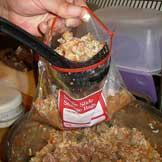
Fiber is an important part of a dog’s diet but does not get the recognition it deserves. The word “fiber” typically refers to “partially digestible or indigestible carbohydrates.” “Indigestibility” has negative connotations, but in reality, a dog’s diet shouldn’t be 100 percent digestible.
Fiber has three main benefits:
- It increases the volume of food a dog can eat without adding much in the way of calories. This can help a dog lose or maintain his weight without feeling hungry.
- It adds bulk to the feces. As long as it is not taken to extremes, fiber promotes normal defecation and can prevent anal gland impaction.
- It provides nutrients to the bacteria that reside in the large intestine.
I want to focus on this third topic today but need to fine-tune our definition of fiber first.
Different types of fiber are described as either insoluble dietary fiber (IDF) or soluble dietary fiber (SDF). Examples of IDF include cellulose, hemicelluloses, and lignins. They pass through the gut essentially unchanged. When included in the diet in appropriate amounts they confer the first two benefits mentioned above. Used to excess, they can be described as “fillers” — cheap ingredients that don’t bring much in the way nutrient value to the diet.
Chicory, inulin, fructooligosacharides, pectins, and plant gums are examples of soluble dietary fiber. A dog’s own digestive enzymes and chemicals don’t have much of an effect on SDF, but the bacteria that live in his large intestine can break them down through the process of fermentation. The end products of fermentation — short chain fatty acids in particular — are very important for the health of the cells that line the large intestine and can even be absorbed as an energy source.
Unfortunately, there is no easy way to determine how much SDF is included in a dog food. With the exception of some prescription diets, the only measure of fiber included on the label is crude fiber (CF). Measurements of CF can give you an idea of how much IDF is included in the diet, but it does not evaluate SDF at all. The best a consumer can do is select foods that include ingredients that are high in SDF such as psyllium husks, guar gum, pectins, oats, barley, chicory, inulin, beet pulp, and some fruits and legumes, or call pet food manufacturers and ask for this information.
Fiber supplements that contain a combination of IDF and SDF are also available. I prefer that my patients get all the fiber they need from a complete and balanced diet, but in cases where additional fiber is beneficial, supplements can be a good option. Talk to your veterinarian if you have any questions about your dog’s nutritional needs.

Dr. Jennifer Coates
Sources:
Coates J. Dictionary of Veterinary Terms: Vet-speak Deciphered for the Non-Veterinarian. Alpine Publications. 2007.
Image: mffoto / via Shutterstock









